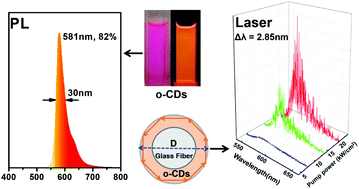Highly efficient and ultra-narrow bandwidth orange emissive carbon dots for microcavity lasers†
Abstract
Luminescent materials with high efficiency, narrow emission bandwidth and long emission wavelength have attracted extensive attention in recent years. However, for novel luminescent carbon dots, it is still a major challenge to obtain these properties simultaneously. Here, this type of carbon dot was proposed using 1,4-diaminonaphthalene as the initial source. The carbon dots demonstrate strong orange emission with the highest quantum yield of 82% and an extremely narrow emission bandwidth of 30 nm. It is found that the orange emission of carbon dots is attributed to the high defect amounts including nitrogen and oxygen doping. The high carboxyl group content leads to a high efficiency and the uniform size distribution results in a narrow bandwidth. The carbon dots are used as the gain medium of a whispering gallery mode microcavity laser. A low excitation threshold of 12 kW cm−2 and a high quality factor of ∼3600 can be obtained from the microcavity lasers. This work has provided a didactic example to develop high-quality long emission-wavelength carbon dots with strong emission and an ultra-narrow emission bandwidth, which makes it possible to expand the application of original and high-performance lasers or other optical devices.



 Please wait while we load your content...
Please wait while we load your content...